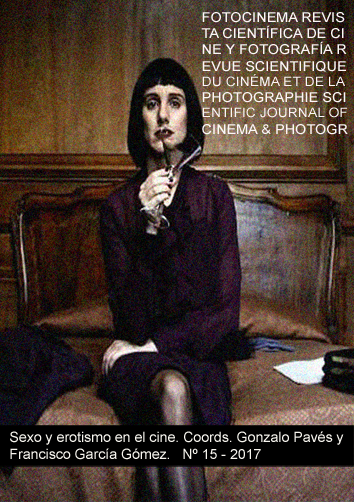Bigas en la boca, Luna entre las piernas. Cine, sexo y gastronomía
DOI:
https://doi.org/10.24310/Fotocinema.2017.v0i15.3495Keywords:
Bigas Luna, cine español, erotismo, gastronomía, sexualidad, Spanish cinema, eroticism, gastronomy, sexualit.Abstract
Existen en el universo cinematográfico de Bigas Luna varios temas recurrentes que se pueden rastrear a lo largo de toda su filmografía. Uno de ellos, quizás el más evidente y persistente, es el del erotismo y su singular maridaje con la gastronomía. Desde luego no ha sido el único cineasta que ha plasmado en el
celuloide esta deliciosa combinación, pero sí que la convirtió en una de las constantes más repetidas y lúcidas de toda su obra. Este artículo busca sintetizar qué pensaba el cineasta sobre
la relación del sexo, los alimentos y el cine, un pensamiento que fue depurando y transformando a lo largo del tiempo, y en segundo lugar, ver como este pensamiento se concretó en una serie de evocadoras metáforas, de corte surrealista, que salpicaron casi todas sus películas.
Abstract:
There exist in the cinematographic universe of Bigas Luna several recurring themes that can be traced throughout his filmography. One of them, perhaps the most evident and
persistent, is that of eroticism and its unique pairing with gastronomy. Of course he has not been the only filmmaker who has captured this delicious combination in the celluloid, but he has turned it into one of the most repeated and lucid constants of all his work. This article seeks to synthesize what the filmmaker thought about the relationship of sex, food and cinema, a thought that was polished and transformed over time, and secondly, to see how this thought came to fruition in
a series of evocative metaphors, of surrealist influence, that they splashed almost all his films.
Downloads
Metrics
Publication Facts
Reviewer profiles N/A
Author statements
Indexed in
-
—
- Academic society
- N/A
- Publisher
- Universidad de Málaga
References
AAVV (1992). Bigas y Luna. Gijón: Festival Internacional de Gijón.
Alegre, L., Barreiro, J., Gistaín, M., Sánchez, A. & Sánchez, B. (1999). Bigas Luna. La fiesta de las imágenes. Huesca: Festival de cine de Huesca.
Berthier, N., Larraz, E., Merlo, P. & Seguin, J.C. (2001). Le cinema de Bigas Luna. Toulouse: Presses Universitaries du Mirail-Cinespaña.
Blaya, N. (2008). “IN=DENTRO. Los fluidos: Agua, leche, sangre”. Ingestum, Valencia: Institut Valenciá d’art modern, Generalitat Valenciana. pp. 88-122.
Brillat-Savarin, J.A. (1978). Fisiología del gusto con una lectura de Roland Barthes, Madrid: Cupsa Editorial, Madrid.
Cavalieri, R. (2015). “Il gusto alimenta l’eros”. Conjectura: Filosofía e Educaçio, Caixas do Sul, v. 20, nº 1, pp. 23-27.
Espelt, R. (1989). Mirada al mon de Bigas Luna. Laertes: Barcelona.
Fantoni Minnella, M. (2000). Bigas Luna. Roma: Gremese Editore. Martí Font, J.M. (1979). “Bigas Luna. El erotismo es una tontería”. Star, nº 51, octubre 1979, pp. 4-8.
Miñarro Albero, Lluis (1978). “Entrevista a Bigas Luna”. Dirigido por, nº 58, noviembre 1978, pp.17-20.
Morris, D. (2004). La mujer desnuda. Barcelona: Editorial Planeta.
Pisano, I. (2001). Bigas Luna. Sombras de Bigas, luces de Luna. Madrid:Sociedad General de Autores y Editores.
Rodríguez González, Félix (2011). Diccionario del sexo y el erotismo. Madrid: Alianza Editorial.
Sanabria, C. (2009). “La otra producción visual de Bigas Luna”. Escena. Revista de las artes, 32(64), pp. 81-94. Sánchez, A. (1999). “El cine en el plato”. La fiesta de las imágenes, Huesca: Festival de cine de Huesca.
Sanabria, C. (2010). Bigas Luna. El ojo voraz, Barcelona: Laertes.
Weinrichter, A. (1992). La línea del vientre. El cine de Bigas Luna, Gijón: Ayuntamiento de Gijón.
Downloads
Published
How to Cite
Issue
Section
License
All contents published in Fotocinema Revista científica de cine y fotografía are protected under the Creative Commons Attribution-NonCommercial-ShareAlike 4.0 International (CC BY-NC-SA 4.0) license. All about this license is available in the following link: <http://creativecommons.org/licenses/by-nc-sa/4.0>
Users can copy, use, redistribute, share and exhibit publicly as long as:
- The original source and authorship of the material are cited (Journal, Publisher and URL of the work).
- It is not used for comercial purposes.
- The existence of the license and its especifications are mentioned.
There are two sets of authors’ rights: moral and property rights. Moral rights are perpetual prerogatives, unrenounceable, not-transferable, unalienable, imprescriptible and inembargable. According to authors’ rights legislation, Fotocinema. Revista científica de cine y fotografía recognizes and respects authors moral rights, as well as the ownership of property rights, which will be transferred to University of Malaga in open access. The property rights are referred to the benefits that are gained by the use or the dissemination of works. Fotocinema. Revista científica de cine y fotografía is published in an open access form and it is exclusively licenced by any means for doing or authorising distribution, dissemination, reproduction, , adaptation, translation or arrangement of works.
Authors are responsable for obtaining the necessary permission to use copyrighted images.














13.png)



